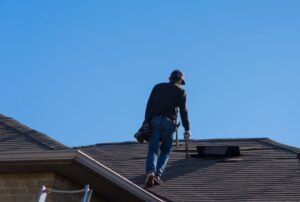Tarping a roof is a process commonly employed in situations where the roof is damaged, leaking, or in need of protection from the elements. It involves covering the roof with a sturdy tarp to prevent further water damage until proper repairs can be made. Let’s explore the when, how, and why behind tarping a roof, as well as other relevant aspects.
One common reason for tarping a roof is during rain or stormy weather conditions. If someone wakes up in the middle of the night to find their roof leaking, emergency tarping can be a temporary solution to minimize water intrusion and potential interior damage. In such situations, it’s crucial to act quickly to protect your home.
Emergency tarping services are often available for homeowners in need, providing immediate roof protection until a repair professional can address the issue. These services can offer full roof tarping, ensuring that the entire roof is covered until the necessary repairs are carried out.
Besides emergency scenarios, there are various other situations that may require tarping a roof. Examples include roof replacements, construction projects, or any situation where the roof may be exposed to the elements for an extended period. Tarping can help protect the roof structure and interior from water damage, debris, and other adverse effects.
When it comes to tarping a roof, it is advisable to hire a professional roofing contractor or a specialized tarping service. They possess the necessary skills, equipment, and experience to safely and effectively tarp your roof. Safety is paramount during this process, especially for roofs at higher elevations. Roofing professionals are trained to take precautions and follow proper safety protocols.
As for the duration a tarp can be left on, it is recommended to repair the roof as soon as possible. Tarps are temporary measures and are not intended for long-term use. Leaving a tarp on for an extended period can lead to additional issues, such as mold or further damage to the roofing structure.
The size of tarps available at local stores can vary, but typically they come in various standard sizes. It is advisable to consult with a store representative to determine the largest tarp available for your specific needs.
While tarping the roof yourself is possible, it is generally recommended to seek professional assistance for optimal results. Hiring experts ensures that the tarp is securely fastened and properly positioned to prevent movement or displacement. They can offer guidance on how to securely tie down the tarp to withstand high winds or storms.
Costs for tarping a roof can vary depending on factors such as the size of the roof and the extent of the damage. It is best to obtain quotes from local roofing professionals or tarping service providers to get an accurate estimate for your specific situation.
When it comes to the quality of tarps, it is advisable to invest in a durable, high-quality tarp that can withstand the elements. Cheaper, lower-quality tarps may be prone to tearing or deterioration, which could compromise their effectiveness in protecting your roof.
Properly securing a tarp involves using ropes, bungee cords, or straps to firmly hold it in place. These securing methods should be evenly distributed across the tarp’s edges to minimize any potential movement during high winds or storms.
After using a tarp, it is important to clean it, dry it thoroughly, and store it in a cool, dry place. This will help prolong its lifespan and ensure it remains in good condition for future use.
While renting a tarp may not be a common practice, they can often be purchased from home improvement stores, roofing supply companies, or online retailers. These places can also provide guidance on the best places to buy tarps for emergency situations.
Some roofing contractors or tarping services specialize in emergency roof tarping. They understand the urgency of protecting your home and can provide prompt and reliable tarping services. It is advisable to research and contact local roofing professionals or disaster response teams to inquire about specialized services in your area.
When tarping a roof, it is essential to prioritize safety. Wear appropriate clothing, including non-slip shoes, gloves, and protective eyewear, to minimize the risk of accidents or injuries during the process.
Tarping a roof during rainfall is generally not recommended unless it is absolutely necessary for emergency purposes. Working on a wet roof can be dangerous, increasing the risk of slips and falls. It is best to wait for favorable weather conditions before attempting to tarp a roof.
In summary, tarping a roof is a temporary solution to protect against water damage and other external elements. Employing professionals for tarping services, focusing on safety precautions, and using high-quality tarps are all essential aspects of this process. Remember to address the underlying issues with your roof promptly to avoid further damage and ensure the long-term integrity of your home





